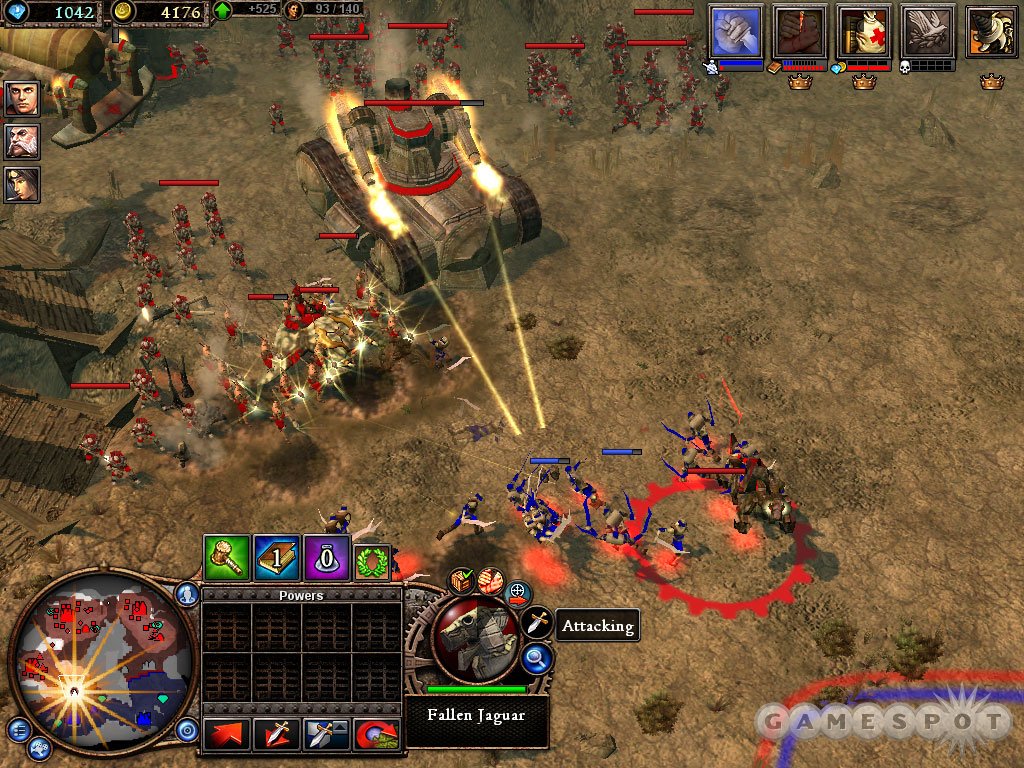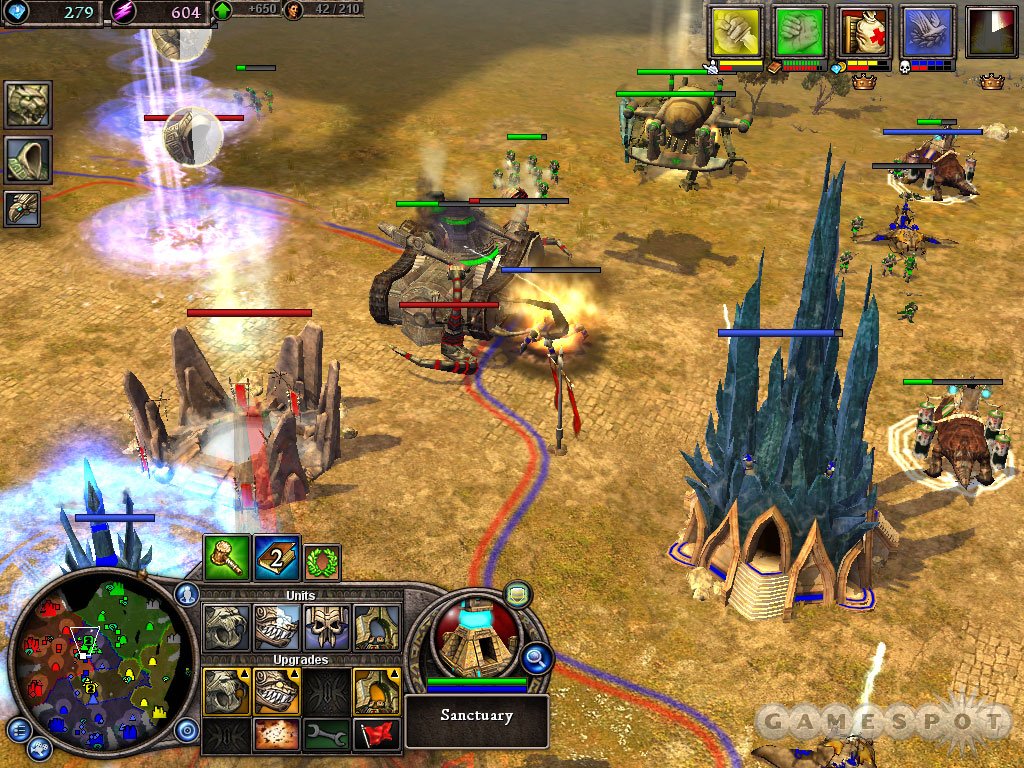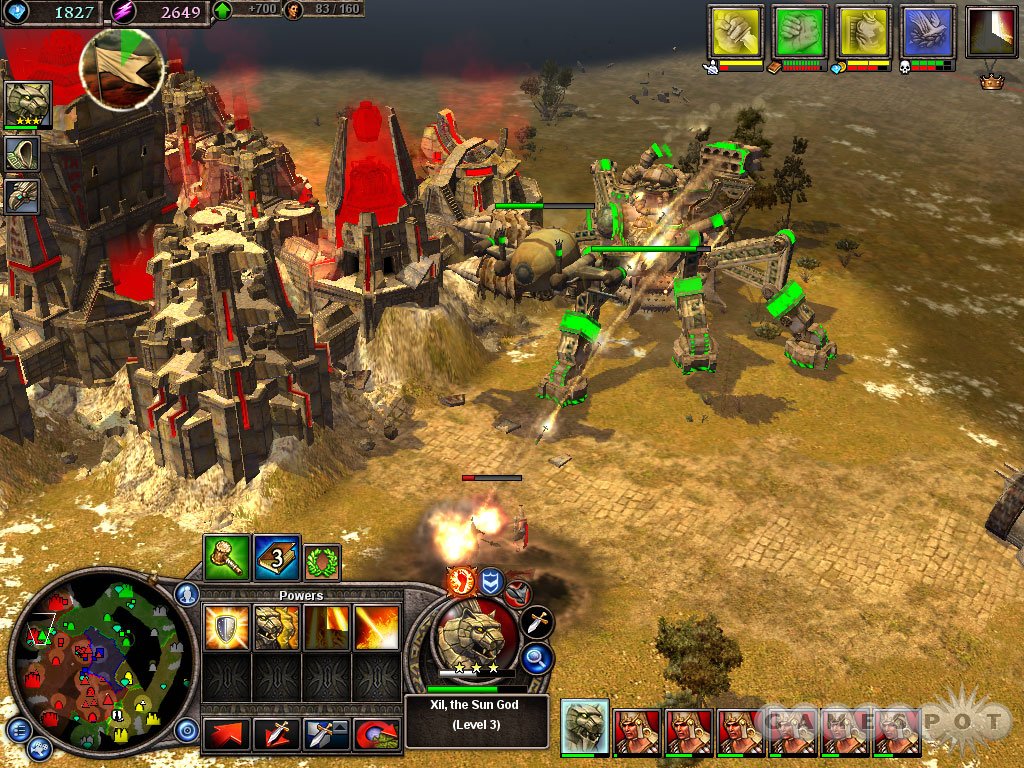Rise of Nations: Rise of Legends Updated Hands-On - Multiplayer Head-to-Head, Dominances, and More
We go head-to-head with Big Huge Games to test Rise of Legend's multiplayer. Needless to say, we got it handed to us, but we had fun in the process.
You may have had the chance by now to check out the
First, it's worth mentioning the multiplayer interface. Big Huge took a lot of lumps for the multiplayer gameplay in Rise of Nations, as finding and staying connected in a game was a lot harder than it should have been. The server browser was fairly rudimentary, and the game itself was unstable. That's changed quite a bit in Rise of Legends, as the multiplayer browser is designed to be as user friendly as possible (it's inspired by the Windows XP login screen), and we played a couple of lengthy games with no connection issues at all, which is a good sign. Setting up a game is easy, and we quickly got a two-versus-two game set up (the artificial intelligence was handling one of the player spots) with a few clicks.

In the first game we played as the Cuotl, the mysterious third faction that uses technology so advanced that it appears magical. This was a brave choice, considering we had the least amount of time playing the Cuotl, and Tim Train, executive producer of Rise of Legends, told us that the Cuotl are something of an "expert" race, meaning that they play differently enough from the others that it takes a while to adapt to them. True enough, we quickly discovered the Cuotl may possess some advanced technology, such as shields and beam weapons, but the limitations on them include the fact that you have to generate energy (the other two races don't worry about this), as well as worry about mining timonium, the game's universal resource. The easiest way to generate energy is to build reactor districts onto Cuotl cities, but thanks to the escalating price of adding districts to a city (each additional district you add costs more than the one before it), you have to make some serious strategic decisions early on about how to proceed. You can try and quickly conquer a neighboring city, since it's cheaper to build districts in small cities than in larger cities. If you try this route, that means you can use the Cuotl's unique domination ability to quickly subvert the city (at the cost of timonium), or you can use your armed forces and try to conquer the city militarily.
While most real-time strategy games are easily defined as having two phases (the long build-up phase and then the combat phase), Rise of Legends compresses the build-up phase a considerable amount. You won't have 10 to 15 minutes to build up like you might in traditional real-time strategy games. Instead, you may only have a few minutes before you start rubbing against the enemy's borders and the fun begins. From that point on, it's a race to expand by conquering or assimilating neutral cities, building up military forces and defenses, researching the tech tree, and attacking and defending.

As with any good real-time strategy game, the gameplay consists of making a constant stream of strategic decisions. Do you spend your limited resources building a lot of weaker units quickly or try and hoard resources until you can build a few powerful units? An enemy attack or raid into your territory may force your hand. Or perhaps you aren't generating resources quickly enough. Then you may need to seize a nearby territory that has a timonium deposit on it so you can mine, but that also means building more districts in your cities to raise your resource-gathering cap, and that's a process that will end up eating away precious resources. Which technologies do you unlock? Rise of Legend's technology tree doesn't let you unlock every technology, which means you have to choose which ones to go for, and that will affect your strategy in the game. You might want faster miners, but that means giving up better combat units.
Dominating Dominance
The two-versus-two game that we played was characterized by wild reversals of fortune. Early on, we found ourselves on the defensive against one of Big Huge Games' best veterans. However, our own Big Huge Games teammate came to our rescue, and we pushed the enemy back and then seized a valuable resource deposit in the middle of the map. (You can suggest to an ally to attack a certain point on the map, and that will appear on the minimap.) We then fortified this central area and slowly built up our forces after we quickly discovered that the enemy's defenses were too formidable for our regular units, especially with attrition kicked in. Attrition is another one of those ideas from Rise of Nations. Basically, if you're in enemy territory and you don't have a special kind of supply unit, your units will take continual damage, reflecting the idea that they're cut off behind enemy lines. 
However, by about the 40 or 50 minute mark, it was clear that the stalemate was going to rapidly end. That's because the game has some safeguards built in to ensure it doesn't drag out. These safeguards are the super units for each faction. It takes a lot of construction before you can unlock and build these units, but once you have them, they can be utterly devastating to the enemy. Train told us that it's possible to stop these super units with regular forces, but odds are you'll be so exhausted from the effort that the game is effectively over. The only real counter is to build super units of your own. And, sure enough, we quickly discovered to our detriment how effective these super units can be. While we were busy massing our forces in the middle of the map, the computer player that we had kept cornered for most of the game had slowly built up its forces, and then it unleashed a huge wave of them at Train's nation. Very quickly, his cities fell, including his capital city, which Train admitted to us afterwards was partly his fault. To maximize his economy, Train had built mostly economic districts in his capital, which meant that while this boosted his economy, it also made his city vulnerable because economic districts aren't that great for defense. With Train's key cities knocked out, it was only a matter of time before our human opponent unleashed his massive super units, and the site of a spider-legged war machine the size of a small city pretty much spelled the end for us.
While we managed to get the two-versus-two game done in less than an hour, that's still a far cry from the idea that you'll be able to play Rise of Legends during your coffee break, which is what Big Huge Games likes to say. We got to experience that in a one-versus-one game against Train himself, and he quickly showed us how you can get a multiplayer game finished in about 20 minutes (or in our case, 21 minutes). With a smaller map designed for two players, it only takes a couple of minutes before each side encounters one another, and then it's a crazed rush to knock the enemy off balance and maintain the initiative, which we failed to do. (To be fair, the executive producer was gracious enough to concede that we didn't have the luxury of playing the game for the past two years like he has).
Over the course of the games that we played, we also got a sense of how important some of the powers can be. Each faction has its own unique power, such as the Alin ability to summon an army instantly or the Cuotl sunburst, a devastating laser beam from orbit. These powers recharge slowly once you use them, though, so you can't go too crazy with them. There are also dominances, special powers that are rewarded to the side that has the largest army or the biggest economy. For instance, if you have tactical superiority, you have the ability to request a cease-fire, which means that no one can attack one another for 15 seconds. This gives you enough time to disengage your units and have them fall back. Or, if you have resource dominance, you have the ability to instantly heal your units, which can be incredibly powerful if used at the right moment. Again, these powers recharge slowly after you use them, so it's all about getting a dominance and knowing when to use it to maximum effect.

We played what looked like a close-to-final version of the game. Train said the studio was still working to stomp out the last lingering bugs, but the game felt a lot more polished than the recent single-player demo. The visuals look impressive, and we should note just how good the factions look. Each side possesses incredibly unique units, from the clockwork war machines of the Vinci to the animal-like units of the Cuotl to the mythological units of the Alin. More importantly, each faction definitely has a different feel and play style to it, which is a big step from Rise of Nations, where the dozen or so nations in that game were fairly comparable to one another. The multiplayer component of Rise of Legends is definitely intense, and it should be as fast-paced and cutthroat as any other real-time strategy game out there. The game is almost done, and we can look forward to it shipping next month.
Got a news tip or want to contact us directly? Email news@gamespot.com
Join the conversation